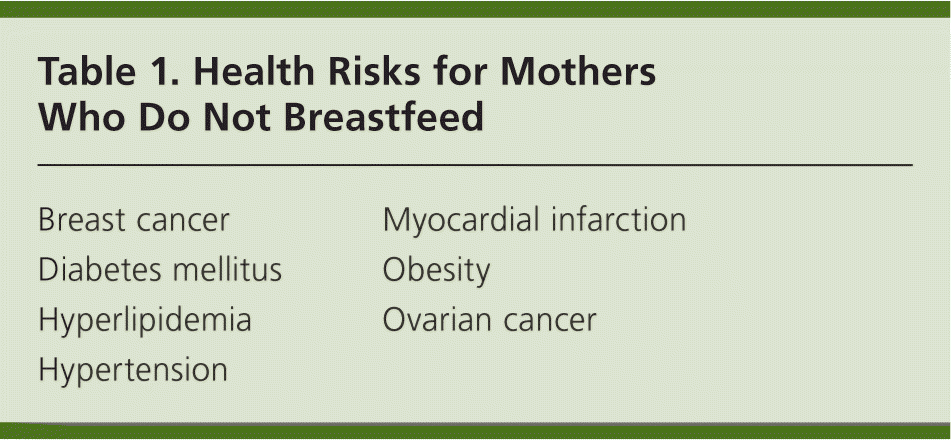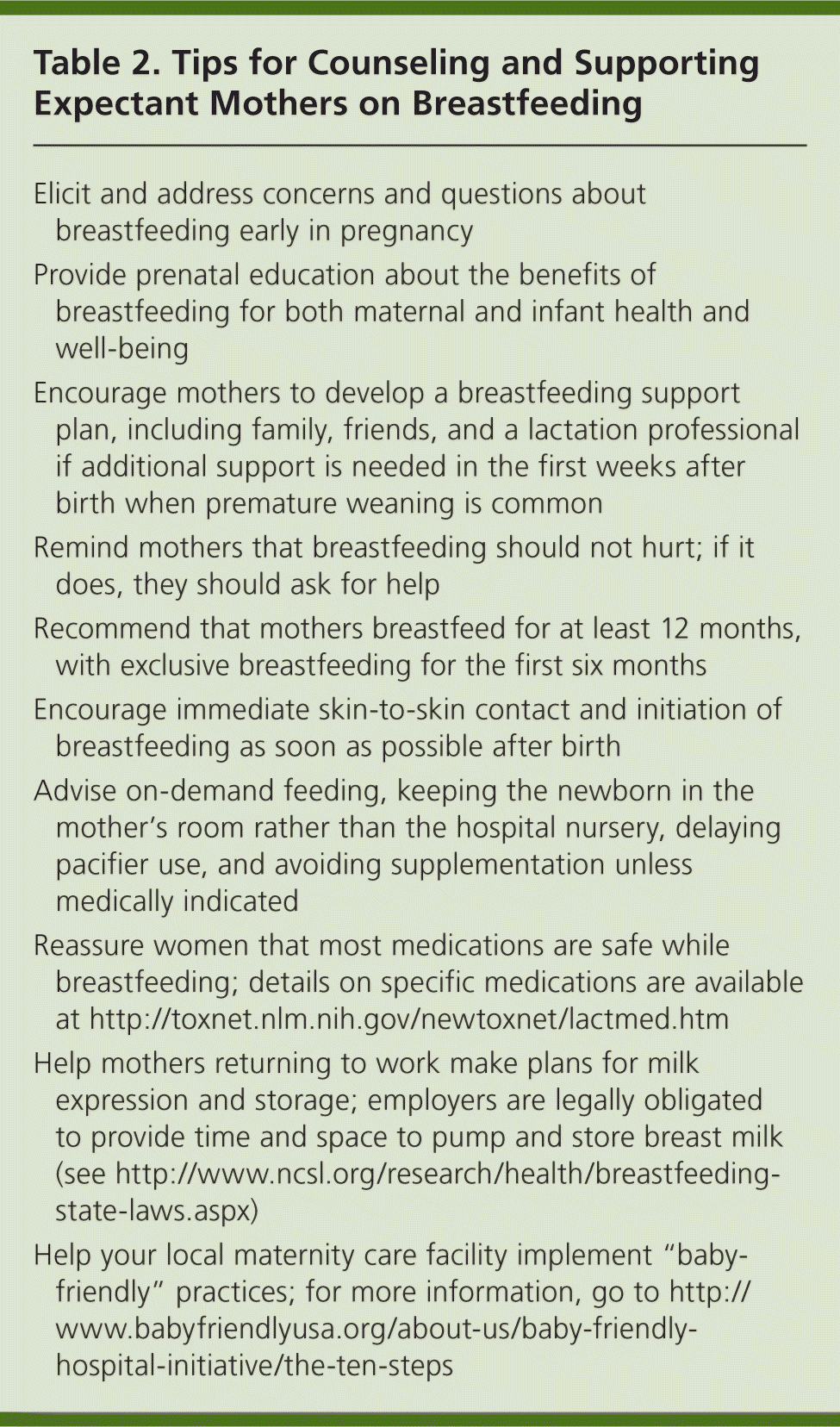
Am Fam Physician. 2015;91(9):602-604
Author disclosure: No relevant financial affiliations.
Effective breastfeeding support is a fundamental component of providing family-centered care. For many years, the American Academy of Family Physicians and other leading health organizations have recommended that infants be breastfed for the first 12 months of life, and exclusively breastfed for the first six months.1 However, in 2011, only 19% of U.S. mothers met these goals.2 Although the Centers for Disease Control and Prevention and the World Health Organization have identified 10 evidence-based ways that maternity care facilities can promote breastfeeding,3 currently less than 7% of U.S. births occur in maternity facilities committed to these “baby-friendly” practices.4 This is unfortunate, because breastfeeding is known to reduce pediatric infections (e.g., otitis, pneumonia), immune disorders (e.g., leukemia, inflammatory bowel disease), and death in the first year of life.5
Maternal health also suffers when weaning occurs prematurely (Table 1), with those who do not breastfeed at all facing the greatest health risks. For example, breast cancer is more common among mothers who do not breastfeed. A meta-analysis of 47 studies found that for each year a mother breastfeeds, her risk of invasive breast cancer is reduced by more than 4%.6 Among mothers who carry the BRCA1 mutation, the benefits of lactation are even more dramatic; in another meta-analysis, mothers who were positive for the BRCA1 mutation and breastfed for at least one year had a 37% lower risk of breast cancer.7 Ovarian cancer is also more common among mothers who do not breastfeed. In a meta-analysis of five prospective cohort studies and 30 case-control studies, mothers who never breastfed were 32% more likely to develop ovarian cancer.8

| Breast cancer |
| Diabetes mellitus |
| Hyperlipidemia |
| Hypertension |
| Myocardial infarction |
| Obesity |
| Ovarian cancer |
Recently, a growing body of literature has indicated that lactation plays a critical role in a mother's long-term metabolic health. Milk production, which requires approximately 500 kcal per day for an exclusively breast-fed infant, reduces maternal obesity in later life.9 Further, mothers who breastfeed have less visceral obesity and smaller waist circumferences in later life,10 which lowers maternal risk of diabetes mellitus11 and hyperlipidemia.12 Impressively, mothers who breastfeed for as little as one month face a significantly lower risk of diabetes in later life than mothers who do not breastfeed at all.13 Among mothers with gestational diabetes, lactation is particularly important for risk reduction.14
Breastfeeding also affects maternal risk of hypertension.15,16 Lactation involves multiple hormones, including oxytocin, prolactin, and cortisol, all of which affect blood pressure. In a cohort study, compared with mothers who breastfed according to national guidelines, those who never breastfed were 29% more likely to develop hypertension, even after adjustment for lifestyle factors and family history.16 These differences in blood pressure persisted well into menopause.15
Heart disease is the leading cause of death among American women. Data from the Women's Health Initiative indicate that mothers who breastfed for seven to 12 months after their first delivery were 28% less likely to develop cardiovascular disease than mothers who never breastfed.15 In the Nurses' Health Study, compared with mothers who never breastfed, women who lactated for two or more years had a 23% lower risk of coronary heart disease, even after adjusting for age, parity, lifestyle factors, family history, and early adult obesity.17 In studies that have objectively measured subclinical cardiovascular disease, using electron beam computed tomography or ultrasonography to examine women's coronary and carotid arteries, significant differences were noted with duration of breastfeeding.18 Compared with mothers who breastfed all of their children for at least three months, those who never breastfed were more than five times as likely to have aortic calcification, even after adjusting for socioeconomic status, lifestyle, family history, body mass index, and traditional risk factors for cardiovascular disease, such as C-reactive protein levels.18
If 90% of U.S. mothers were able to breastfeed for one year after every birth, an estimated 14,000 heart attacks would be prevented each year, and 54,000 U.S. women could avoid treatment for hypertension.19 Reducing this disease burden could save the United States billions of dollars annually, preventing more than 4,000 premature maternal deaths19 and close to 1,000 infant deaths each year.20 Mothers are more likely to breastfeed when they are encouraged to do so by their physician,21 yet prenatal discussions of breastfeeding are often inadequate.22 Table 2 offers tips for counseling and supporting expectant mothers on breastfeeding. As variations in maternity care practices account for considerable disparities in infant feeding,23 improving antenatal and perinatal lactation support is an urgent public health priority that requires leadership from U.S. family physicians.

| Elicit and address concerns and questions about breastfeeding early in pregnancy |
| Provide prenatal education about the benefits of breastfeeding for both maternal and infant health and well-being |
| Encourage mothers to develop a breastfeeding support plan, including family, friends, and a lactation professional if additional support is needed in the first weeks after birth when premature weaning is common |
| Remind mothers that breastfeeding should not hurt; if it does, they should ask for help |
| Recommend that mothers breastfeed for at least 12 months, with exclusive breastfeeding for the first six months |
| Encourage immediate skin-to-skin contact and initiation of breastfeeding as soon as possible after birth |
| Advise on-demand feeding, keeping the newborn in the mother's room rather than the hospital nursery, delaying pacifier use, and avoiding supplementation unless medically indicated |
| Reassure women that most medications are safe while breastfeeding; details on specific medications are available at http://toxnet.nlm.nih.gov/newtoxnet/lactmed.htm |
| Help mothers returning to work make plans for milk expression and storage; employers are legally obligated to provide time and space to pump and store breast milk (see http://www.ncsl.org/research/health/breastfeeding-state-laws.aspx) |
| Help your local maternity care facility implement “baby-friendly” practices; for more information, go to http://www.babyfriendlyusa.org/about-us/baby-friendly-hospital-initiative/the-ten-steps |
